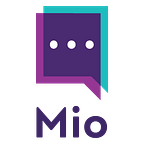How to sync Slack and Cisco Webex in 5 minutes
Ready to sync Slack and Cisco Webex?
Great. So are we.
Here’s what you could be doing:
Getting the right collaboration solution in today’s dynamic communication environment is rarely about pushing your team into a one-size-fits-all tool.
Everyone in your workforce has their own preferences and needs. Some will have spent years in the Cisco network and might feel uncomfortable using a tool from another brand. Other employees might prefer Slack and it would be counterproductive moving to Cisco.
While there’s plenty of guidance out there on how to migrate from one system to another, there isn’t as much advice on having your cake and eating it too.
The good news? You can sync Slack and Cisco Webex to support everyone in your team.
Even better? It takes less time than you’d think.
Step 1: Set up your Mio Hub for Slack and Cisco Webex
The first thing you need to connect Slack and Cisco Webex is Mio.
Mio keeps your team collaborating and communicating, regardless of which app they prefer to use. By translating every message your employees send in real-time, Mio bridges the gap between different workspaces, teams, and apps.
To get started, visit the Mio website here, and click “Get Started.”
A Mio rep will be in touch with a link to your private Mio hub — the administration tool for Mio. Here, you create service accounts for each of the collaboration platforms you want in your integration.
Step 2: Completing the Hub information
You’ll need to provide some basic information to get your Mio hub up and running.
For instance, we’ll need:
- Your business name and a logo
- Your preferred admin email address
- A name for your Mio subdomain
- Service account information for Slack and Cisco Webex
Mio’s technology will automatically scale your cloud service to support your business. We will need some app permissions for Slack and Cisco. For instance, for Slack, we’ll need:
- Admin — for workplace administration
- Channels: History — to view activity, messages, and files in channels
- Channels: Read — to view member lists, channel names, topics, and messages
- Chat: Write: Bot — to send messages in Slack
- Chat: Write: User — to send messages as you
- Files: Read — to view comments, files, sharing and uploading history
For Webex, we’ll need access to things like:
- Spark: All — for full access to your Webex accounts
- Spark: People_Read — to access your user’s directory
- Spark-admin: Roles_read — to read the roles in your organization
Step 3: Syncing your Slack and Webex channels with Mio
Once your accounts are fully set up, and Mio has the correct permissions in your apps, we’re ready to sync.
We’ll walk you through the basics of using your own admin hub on Mio. Expect to map out a few channels and set up direct messages for users in certain spaces, so you’re ready to self-administer.
Additionally, we can give you an overview of the management interface, and how you can use it to your advantage. To sync Slack and Cisco Webex channels:
- Click on “Create new Sync”
- Select your Slack and Cisco Webex applications
- Choose the channel you want to sync with our innovative search function
- Use the button to connect two channels, or the arrow buttons to add the channel to the other platform
- Rename newly created channels
- Add as many channels as you like
- Review and sync your channels on the following page
On your primary Team Sync page, you’ll be able to see your Slack and Cisco Webex channels syncing. Each channel will appear as “pending” until the sync is complete.
Step 4: People Sync
When you’ve connected Slack and Cisco Webex , the next step is to sync your users.
To sync direct messages across platforms, we require all members in a team to complete a one-time authorization. You can prompt your users to do this by sending a message to your employees via your service user account.
Alternatively, you can apply the “Auto-Prompt” feature in Mio. This automatically sends prompt messages to users when they send a direct message to a colleague using a different platform. In Slack, the prompt message will appear in the “Apps” sidebar. In Cisco Webex, the prompt will show up in the direct chat area.
You’ll be able to check each of your user’s syncing status at a glance.
Mio will show people with:
- “Synced on” for synced users
- “Synced off” for people who haven’t synced yet
- “Sync pending” for people who have been prompted but haven’t authorized Mio yet.
Step 5: Scale your strategy
Finally, all that’s left is to watch your collaboration campaign thrive.
Synced users will be able to participate in direct messages with users on other platforms, share files, and more, for easy teamwork across boundaries.
You won’t have to worry about finding ways to bridge the gaps between different employees that prefer to use their favorite apps anymore. With Mio, you can ensure that everyone gets the freedom they need to use the tools they love, without compromise.
Once you’ve completed your proof of concept, we’ll ensure that you can get the most out of your ongoing Mio experience. We’ve got plenty of guidance to share on the best practice approach to rolling Mio out for countless users.
With Mio as your interoperability solution, connecting your teams has never been easier. Check out our demo video to see Slack and Webex interoperability in action, then sign up to get started today.
We’re always striving to provide the best user experience and give you more insight to your Slack and Webex usage. That’s why our latest product update consists of a revamped admin UI and new features to make onboarding and management of Mio simpler than ever.
